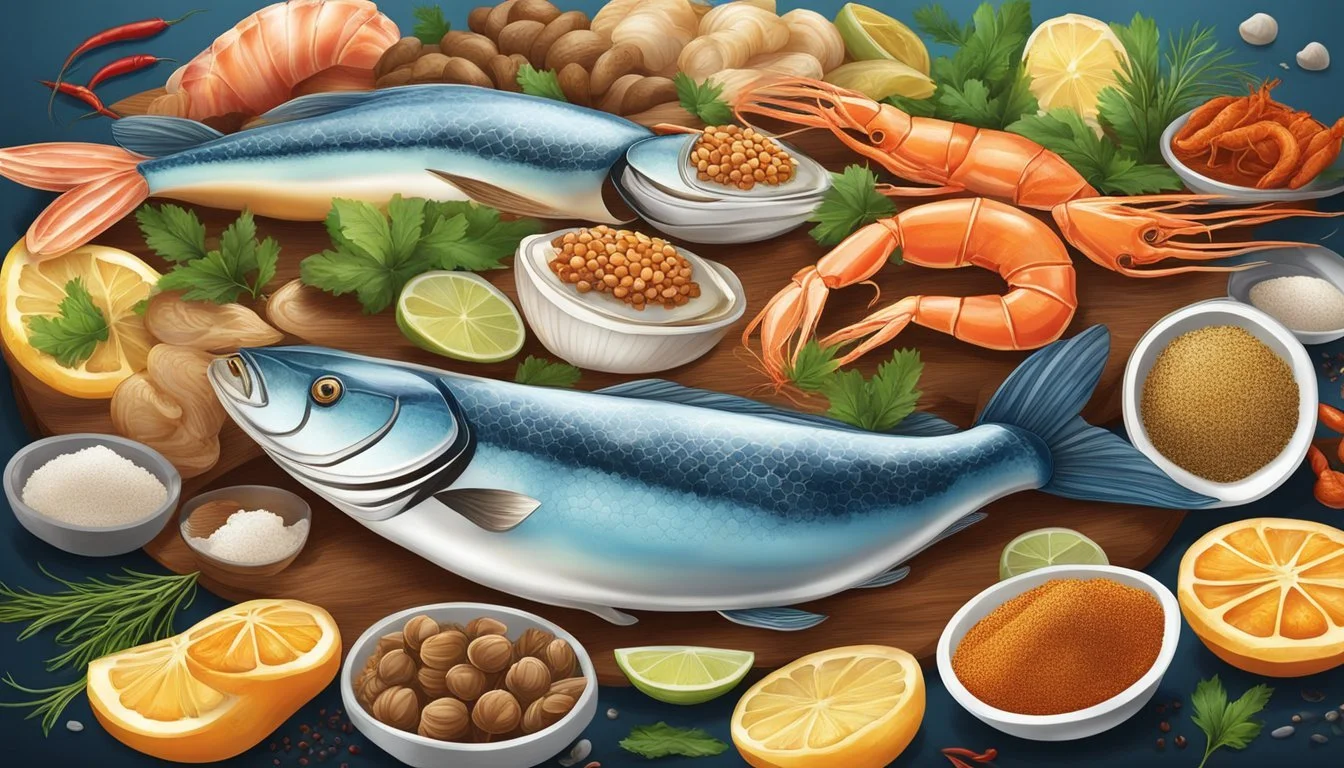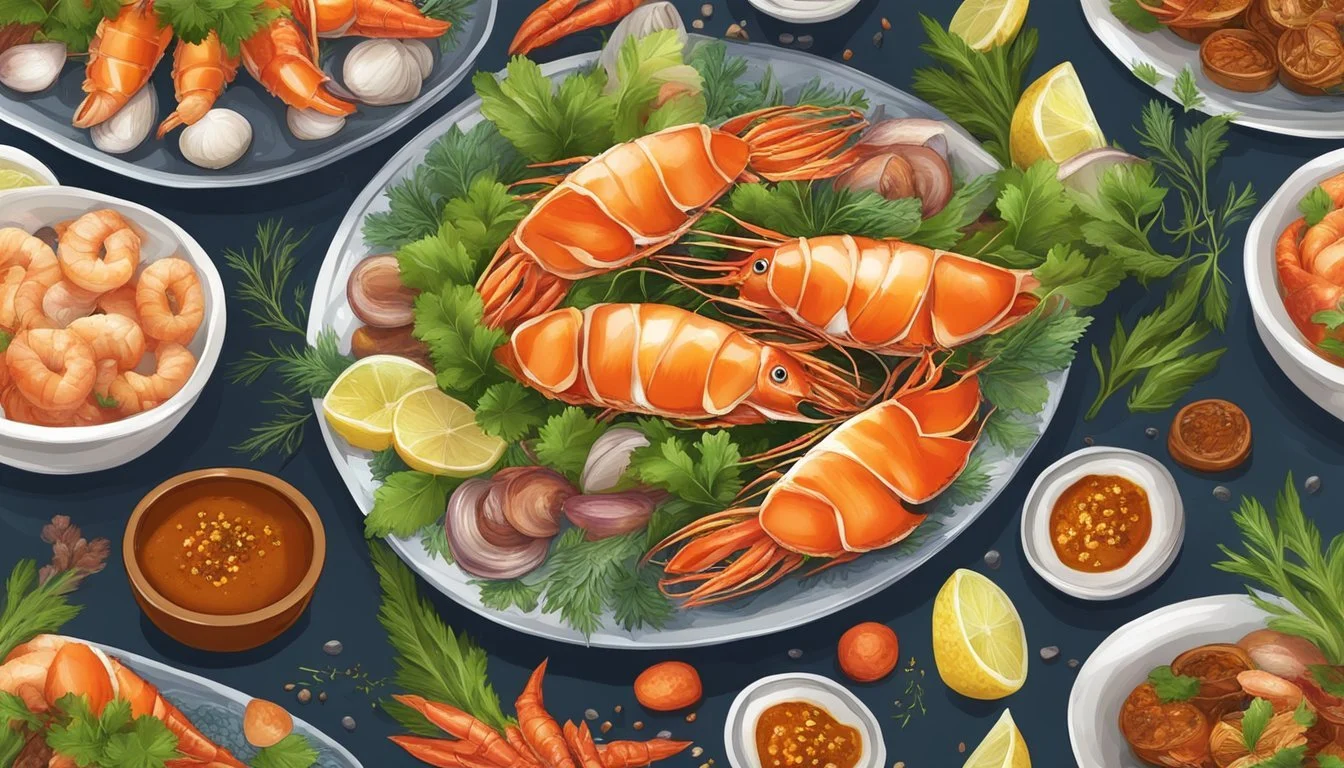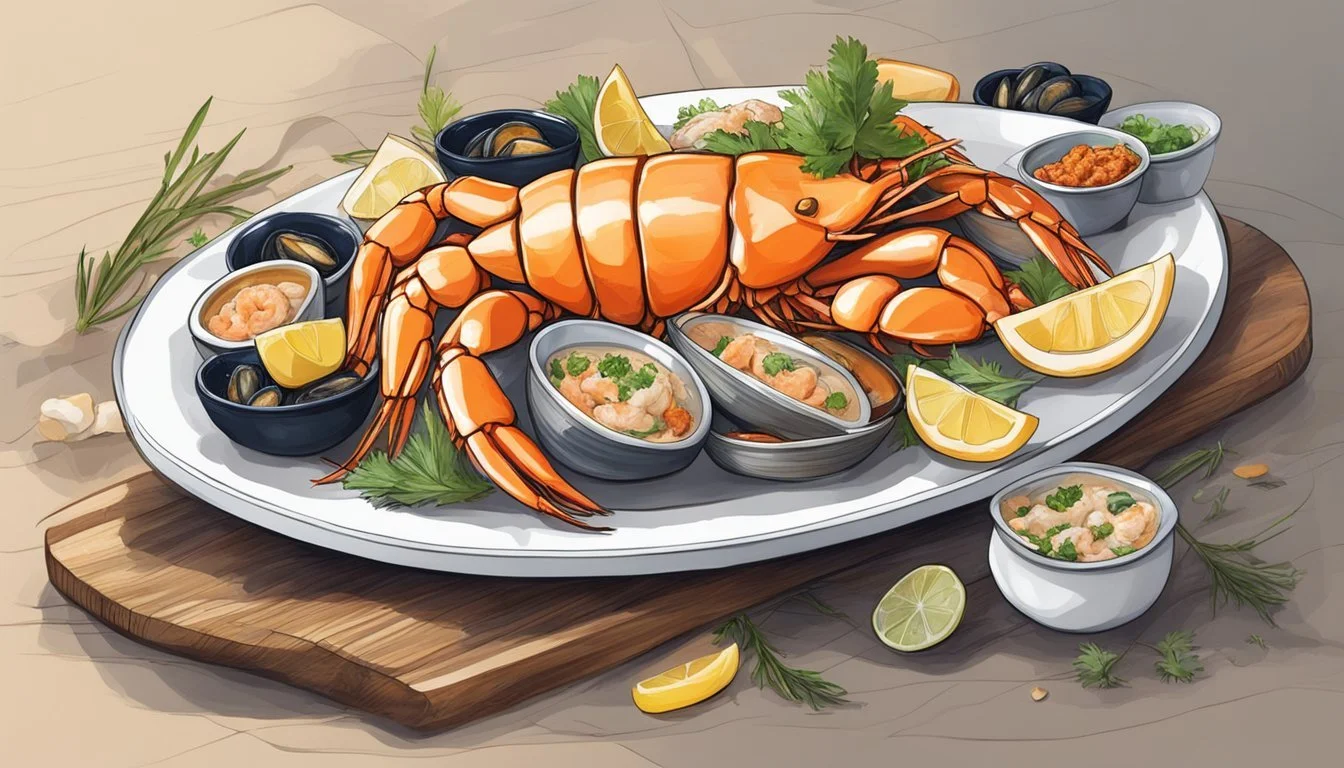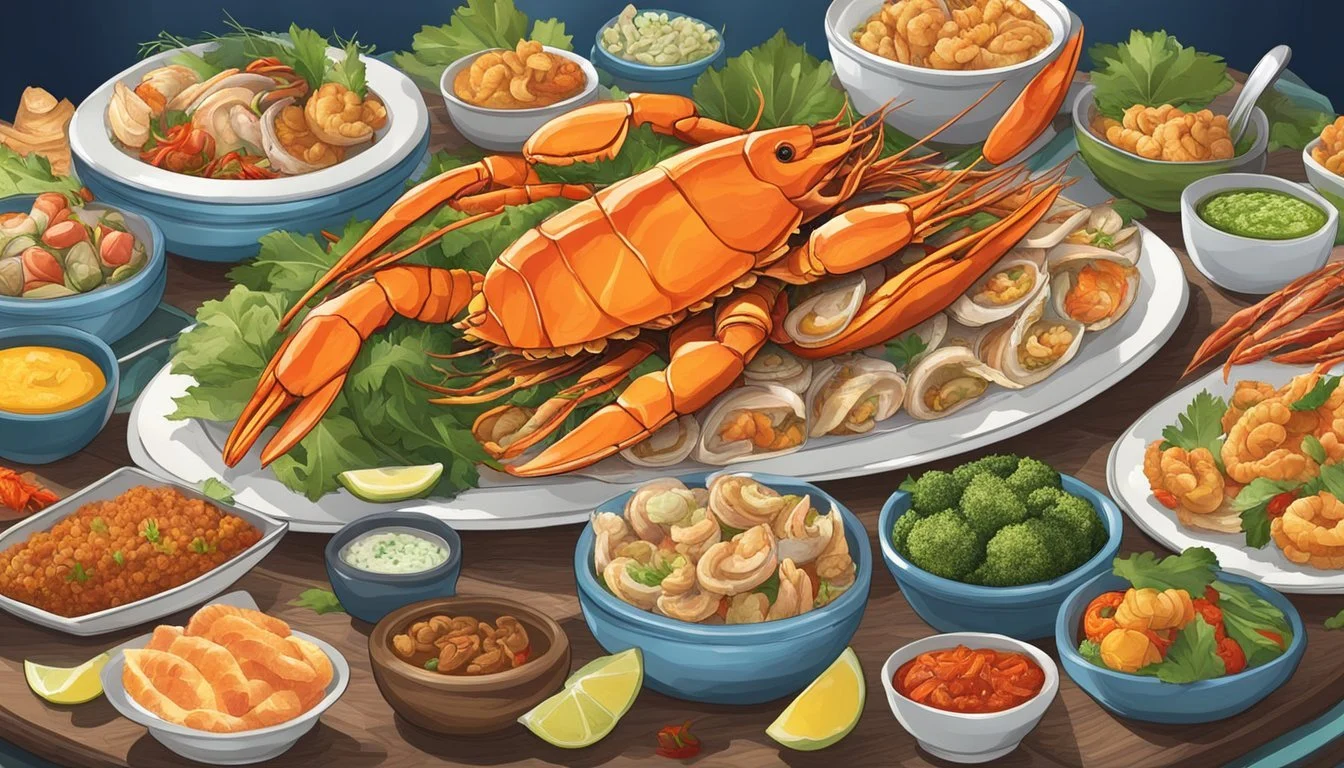Swicy Seafood Delights
Mastering Sweet and Spicy Ocean Flavors
Swicy seafood (What wine goes well with seafood?) is rapidly gaining popularity, bringing the exhilarating fusion of sweet and spicy flavors from the ocean to the forefront of culinary innovation. This trend capitalizes on the unique ability of sweetness to complement and sometimes tame the heat from spicy elements in a dish. As palates around the world seek new experiences, swicy seafood satisfies with its complex flavor profiles, combining the natural brininess of the sea's bounty with the dynamic pairing of sugar and spice.
Restaurants and chefs are exploring this territory more than ever, contributing to the rising demand for dishes that surprise and delight. They are concocting an array of swicy seafood dishes (What wine goes well with seafood dishes?) that cleverly balance the two sensations. Ingredients like hot honey drizzled over crispy fried shrimp (What wine goes well with shrimp?) or sweet chili glazed salmon demonstrate the versatility and appeal of swicy combinations.
This blend of flavors is not only a treat for the taste buds but also engages a broad range of sensory reactions, creating a memorable dining experience. Swicy dishes appeal to adventurous eaters and comfort food enthusiasts alike, promising a sensory journey that's anchored in the rich and diverse offerings of the ocean. The swicy trend is particularly exciting because it goes beyond mere novelty - it is an exploration of flavor that elevates seafood to new heights, one delectable bite at a time.
Understanding 'Swicy' Flavors
The 'Swicy' flavor profile combines the contrasting tastes of sweetness and spiciness to create a complex and satisfying taste experience, particularly in seafood dishes.
The Concept of Sweet and Spicy
The interplay between sweet and spicy flavors is grounded in the ability of sugar to temper the heat from spices. This balance enhances a dish's taste without overpowering the natural flavors of the ingredients.
Sweet ingredients: Often include sugar, honey, and sweet chili sauce.
Spicy components: Commonly feature red pepper flakes, cayenne pepper, chili powder, and smoked paprika.
Notably, in seafood, these flavors complement the brininess and can involve glazes or marinades using the following common pairings:
Honey and ginger
Brown sugar and soy sauce
Maple syrup and chili flakes
Ingredient Profiles
Seafood dishes that utilize 'swicy' elements often incorporate specific ingredients to achieve the desired balance.
Sugar: Enhances the inherent sweetness in seafood while mitigating spiciness.
Honey: Adds smoothness and sticky consistency, often used in glazes.
Ginger: Offers a piquant zing that pairs well with the natural sweetness of many seafood options.
Red Pepper Flakes and Cayenne Pepper: Provide a robust heat that is subtly countered by sweet elements.
Soy Sauce: Brings umami and saltiness that work in harmony with sweeter notes.
Ketchup: Often used in sweet and spicy sauces, contributes tomato sweetness and vinegar sharpness.
Table of Ingredient Combinations:
Sweet Element Spicy Element Common Use in Seafood Honey Ginger Glazes for salmon or shrimp Brown Sugar Soy Sauce Marinades for fish steaks Ketchup Chili Powder Dipping sauces for fried or battered seafood Sugar Smoked Paprika Dry rubs for grilled seafood Sweet Chili Sauce Cayenne Pepper Sauce base for stir-fried or sautéed seafood
By understanding how these elements blend, chefs can craft 'swicy' dishes that highlight the natural flavors of seafood while delivering a harmonious sweet-spicy experience.
Selecting Ideal Seafood
Choosing the right seafood for sweet-spicy dishes is crucial to achieving the perfect balance of flavors. Freshness and size play a significant role in texture and taste, influencing how the seafood pairs with sweet and spicy ingredients.
Shrimp: The Perfect Canvas
Shrimp serves as an excellent base for sweet and spicy flavors due to its mild taste and firm texture. When selecting shrimp for recipes that call for a sweet and spicy profile, freshness is paramount. Fresh shrimp should have a slight sea breeze scent and firm bodies with shells that are free of spots or blemishes.
For recipes like sweet and spicy shrimp, size matters. Here are some common options:
Small Shrimp: Great for dishes with subtler flavors or when mixed with other seafood, cook for about 2 minutes per side.
Large to Jumbo Shrimp: Ideal for grilling, these larger shrimp provide a satisfying bite and hold up well to bold, robust flavors. Grill larger shrimp for approximately 3 minutes per side or until they are pink on the outside and opaque in the center.
Cooked Shrimp: Can be a time-saver but look for those without added flavors that might clash with your sweet and spicy sauce.
Exploring Beyond Shrimp
While shrimp may be a popular choice, don't overlook other seafood for your sweet and spicy creations. Scallops (What wine goes well with scallops?) are another excellent option, capable of carrying sweet and spicy notes while contributing a unique texture. When shopping for scallops, opt for those that are dry-packed and have a translucent appearance, signaling their quality and freshness.
Other seafood choices include:
Fish: Mild white fish like cod or tilapia can be a good canvas for sweet and spicy flavors.
Shellfish: Mussels (What wine goes well with mussels?) and clams (What wine goes well with clams?) can also be dressed in sweet and spicy sauces, often absorbing the flavors into their broth.
Crustaceans: Lobster (What wine goes well with lobster?) and crab offer a luxurious option for a decadent sweet-spicy seafood recipe.
No matter the seafood, ensure it is sustainably sourced to maintain ocean health and support ethical fishing practices.
Preparation Techniques
In this section, various techniques for preparing sweet-spicy seafood dishes are explained, emphasizing the importance of both marinades and seasonings, and cooking methods.
Marinades and Seasonings
Marinades and seasonings are the foundation of flavor, infusing seafood with sweet and spicy notes. A marinade typically consists of acidic liquid like citrus juice or vinegar, combined with spices and sweeteners. This mix not only adds flavor but can also tenderize certain seafood:
Citrus-based marinades: For a Peruvian-style fish ceviche, chefs combine fresh citrus juice, such as lime, lemon, or sour orange juice, with sweet and spicy elements. Adding finely chopped onions, cilantro, and jalapeños introduces complex flavors.
Dry rubs: A blend of paprika, onion powder, garlic powder, thyme, salt, black pepper, cayenne pepper, and a touch of brown sugar can create a vibrant rub. Applying this rub to seafood, like Swai fillets, imparts a strong sweet and spicy crust when cooked.
Cooking Methods Explained
Seafood thrives under different cooking methods, each bringing out unique sweet-spicy profiles:
On the Stove: A shrimp recipe may instruct chefs to start on medium-high heat with a well-oiled saucepan—often a cast iron pan provides even heat distribution. One can sauté the shrimp until it is beautifully browned, then simmer in the sweet-spicy marinade for deep flavor penetration.
Cooking Tool Heat Setting Cooking Duration Cast Iron Pan Medium-High Heat A few minutes
Grilling: When grilling, seafood can be marinated beforehand and then placed directly on the grill or on aluminum foil to protect delicate pieces. The grill imparts a smoky flavor that complements the sweet-spicy marinade, creating a multi-dimensional taste profile. Hints of umami and char enhance the intricate seasoning applied earlier.
Grill Method Temperature Tip Direct Grilling High Heat Quick sear for caramelization Indirect Grilling Medium Heat Use aluminum foil for even cooking and easy cleanup
Baking: Preheating the oven and using a rub or marinade before baking ensures a consistent crust. For example, coating fish fillets with oil and seasoning, then baking at a controlled temperature, like 375 degrees Fahrenheit, allows the flavors to meld and the fish to cook thoroughly.
The mastery of these preparation techniques is vital to unlocking the full potential of sweet-spicy seafood dishes.
Swicy Seafood Recipes
Dishes that beautifully blend the heat of spices with the sweetness of various sauces offer a gastronomic delight. These recipes not only promise an explosion of flavors but also cater to easy preparation methods, making them perfect for any seafood lover.
Signature Sweet and Spicy Shrimp
This dish brings together succulent shrimp with a vibrant sauce that's both sweet and spicy. Ingredients for the sauce include Sriracha for heat, honey for sweetness, and rice vinegar for a tangy touch. Olive oil is the favored choice for cooking the shrimp to retain their moistness, complemented by a hint of lemon to cut through the richness. One can present the shrimp atop steamed rice, which lends itself as a neutral base to the bold flavors. For convenience, a printable recipe card with a star rating reflecting its popularity often accompanies such recipes.
Preparation:
Heat olive oil in a pan over medium heat.
Sauté shrimp until they turn pink, approximately 2 minutes.
Combine Sriracha, honey, and rice vinegar in a bowl.
Pour the sauce over the shrimp and cook until glazed.
Creative Seafood Combinations
Exploring swicy flavors extends beyond shrimp to include an array of seafood options. Creative dishes might feature a medley of scallops, mussels, and even squid. A sweet and spicy marinade often involves a base of brown sugar, which caramelizes well, paired with bold spices. Nutritional info is usually available for health-conscious diners, particularly when dishes are designed to offer a balanced profile. With a printable recipe card, these seafood combinations are easy to share and enjoy.
Suggestions:
Scallops: Glaze with a brown sugar and chili pepper reduction.
Mussels: Simmer in a tomato sauce spiked with sweet paprika and a kick of cayenne.
Squid: Toss in a sauce made with hoisin for sweetness, balanced with garlic chili paste.
By offering just the right balance of sweetness and heat, these recipes are a testament to the versatility and appeal of swicy seafood dishes.
Complementary Sides and Accompaniments
Selecting the right side dishes enhances the flavors of sweet and spicy seafood, providing a well-rounded dining experience. It's important to balance the heat and sweetness with sides that can complement and contrast these tastes.
Grains and Vegetables
Rice: A staple that perfectly absorbs the bold sauces often associated with sweet and spicy seafood. White rice is ideal for its neutral taste, while brown rice provides additional fiber and a nuttier flavor.
Noodles: Serve noodles such as soba or rice noodles tossed lightly with sesame oil to complement the seafood's texture.
Pasta: Opt for light pasta dishes tossed in olive oil or a simple garlic sauce that doesn't overwhelm the sweet-spicy profile of the main dish.
Vegetables: Steamed or grilled vegetables like asparagus, spinach, and snow peas provide a refreshing crunch and are high in fiber. They offer a fresh contrast to the richness of the seafood.
Sauces and Extras
Cilantro: Fresh cilantro adds a bright, citrusy note, cutting through the richness of sweet and spicy flavors.
Green Onions/Scallions: Garnishing the dish with green onions adds a mild sharpness that pairs well with the savory flavors of the seafood.
Sauces: Consider citrus-infused sauces or a light vinaigrette as an extra for guests who may want to add a tangy kick to their dish.
Bold flavors in seafood call for sides that support and uplift the main course. The complement of grains and vegetables should harmonize with the dish’s tastes, while sauces and extras can be used sparingly to accentuate the flavors.
Diet and Nutrition Information
Swicy seafood dishes, a combination of sweet and spicy flavors, can be both a delectable and nutritious option. Such dishes typically center around seafood, like shrimp, which is known for its high protein content and low fat levels.
Nutritional Content of Common Ingredients in Swicy Seafood:
Shrimp: A popular choice for swicy recipes, it provides essential nutrients and is low in calories. A 3-ounce (85-gram) serving generally contains:
Nutrient Amount Calories ~85 Protein ~18g Fat ~1g
Sauces and Seasonings: While the base of swicy dishes is healthy, the addition of sauces and seasonings can affect their overall nutrition. Ingredients like honey or mango juice used to sweeten the dish contribute additional sugars, while soy sauce or hoisin sauce may increase sodium levels.
When considering the nutritional impact of a swicy seafood dish, one should recognize that seafood is densely packed with nutrients, providing valuable omega-3 fatty acids and vitamins like B12. When consumed in moderation, the sauces contribute to the unique flavor profile while adding relatively minor amounts of fats and calories to the dish.
A balanced swicy seafood plate can be part of a healthy diet. When preparing such dishes, one can adjust ingredient quantities to conform to specific dietary needs, taking into account personal health goals concerning caloric intake, fat, and protein levels. It is also beneficial to be aware of any sauces used to gauge the meal's sodium and added sugar.
Serving and Presentation
When serving swicy seafood, the mode of presentation—whether casual or gourmet—significantly enhances the dining experience, and careful plating amplifies the appeal of these dishes.
From Casual to Gourmet
For a casual setting, swicy seafood appetizers like shrimp glazed with a sweet-spicy sauce can be served in simple bowls or on platters. Finger foods benefit from accompanying paper towels, facilitating a laid-back, party atmosphere. When transitioning to gourmet presentations, swicy seafood entrées transform with elevated accents like citrus-infused butter drizzles, served on fine dinnerware to reflect sophistication.
Plating and Garnishing Tips
Appetizers: Arrange on a small, elegant dish and garnish with a sprig of fresh parsley or cilantro for color contrast.
Entrées: Serve the main dish on a warm plate to maintain the ideal temperature, and use a brush to add a decorative swipe of sauce.
Bowls: For a trendy and comforting approach, serve swicy seafood in a bowl atop a bed of rice or noodles, with contrasting garnishes such as green onion or sesame seeds for an extra pop.
By attending to presentation details, from the casual to the gourmet, and employing these plating and garnishing tips, the appeal of swicy seafood dishes is visually and tastefully elevated.
Tips for Speed and Convenience
When it comes to preparing swicy seafood dishes, efficiency doesn't have to compromise flavor. Swift techniques and clever use of ingredients can elevate your dining experience without demanding hours in the kitchen.
Quick and Easy Seafood Preparations
One can achieve rapid results by selecting seafood that cooks quickly, such as shrimp or thin fish fillets. Marinating these choices in a mixture of sweet chili sauce and a hint of soy sauce infuses a swicy profile efficiently. To thicken sauces and glazes swiftly, cornstarch is an excellent agent; it provides a speedy and reliable method to achieve the desired consistency with minimal cooking time.
Additionally, cooking in foil packets is not only expedient but also encapsulates flavors more intensely. Simply place the seafood with swicy glaze on foil, wrap it securely, and bake. Here's a basic framework:
Lay out a sheet of foil.
Place the seasoned seafood in the center.
Fold the edges to create a sealed packet.
Bake at 400°F (about 200°C) for 10-15 minutes, depending on the seafood's thickness.
Utilizing Leftovers
Leftover seafood can be seamlessly transformed into a new meal by incorporating a swicy element. Use leftover grilled fish or shrimp by tossing them in a swicy sauce, and serve them over rice or greens for a quick lunch or dinner. Using leftovers not only saves time but also reduces food waste. A simple reheating technique that preserves the texture of your seafood:
Place leftovers on a baking dish.
Add a splash of water to avoid drying out.
Cover with foil to retain moisture.
Reheat in the oven at 275°F (135°C) until warm.
Incorporating these quick and easy techniques, from cornstarch for thickening sauces to using foil for cooking, not only speeds up the preparation process but also enhances the flavor of swicy seafood creations, allowing one to enjoy delicious meals without extensive prep or cleanup.
Engaging with Your Audience
When discussing Swicy Seafood, it's essential to tap into the power of social media to reach your audience effectively and provide them with clear instructions that make replicating these flavors easy and accessible.
Sharing on Social Media
One can leverage platforms like Instagram and Facebook to showcase the vibrant appeal of Swicy Seafood dishes. High-resolution photos featuring ingredients like fresh ginger and lime juice can stimulate the senses of followers. It's advisable to include hashtags such as #SwicySeafood and #SweetSpicyOceanFlavors to increase visibility. Here's a compact strategy to enhance social media engagement:
Post mouth-watering images: Both finished dishes and behind-the-scenes preparations.
Utilize stories and reels: Short clips of the cooking process can be intriguing.
Encourage sharing: Ask followers to share their own Swicy Seafood creations.
Providing Clear Instructions
To aid enthusiasts in crafting their own Swicy seafood dishes at home, one should provide easy-to-follow recipes. Clarity is paramount, and this can be achieved with structured steps and the use of printable recipe cards. To illustrate, here is an example format for a recipe card:
Ingredient Quantity Fresh Ginger 1 tbsp, grated Lime Juice 2 tbsp Your chosen seafood Appropriate serving
Instructions:
Combine fresh ginger and lime juice with other spices to create the Swicy marinade.
Apply the marinade to the seafood and let rest for flavor infusion.
Cook as preferred and enjoy the sweet-spicy delight.
By ensuring the recipes are straightforward and making them readily available in a printable format, one facilitates a practical and enjoyable cooking experience.
Conclusion
The emergence of swicy seafood on culinary scenes underscores a trend toward complex, multi-dimensional flavor profiles. Sweet-spicy combinations derived from the ocean's bounty cater to palates seeking novelty and balance. Swicy dishes marry the innate brininess of seafood with glazes, sauces, and marinades that entice through contrast and complement.
Examples: Grilled shrimp with a sweet chili sauce or a honey-glazed salmon with a hint of cayenne pepper.
Popularity: Restaurants have noted the burgeoning preference for swicy flavors in seafood dishes, contributing to inventive menus that standout in a competitive food industry.
Endorphin Release: The combination of sugar and spice not only pleases the palate but also triggers the release of endorphins, enhancing the dining experience.
The benefits of swicy combinations extend beyond mere taste, often stepping into health territory. For example, the capsaicin in chili peppers, a common spicy component, possesses metabolism-boosting properties.
Consumer Interest:
Increase in demand for swicy options.
Market Research: Indicates a positive trend in the adoption of sweet and spicy flavors by consumers.
In essence, swicy seafood is not a passing fancy but a reflection of evolving consumer preferences and culinary innovation. As chefs continue to explore this territory, diners can anticipate a growing array of swicy seafood offerings that promise to deliver both satisfaction and surprise.










